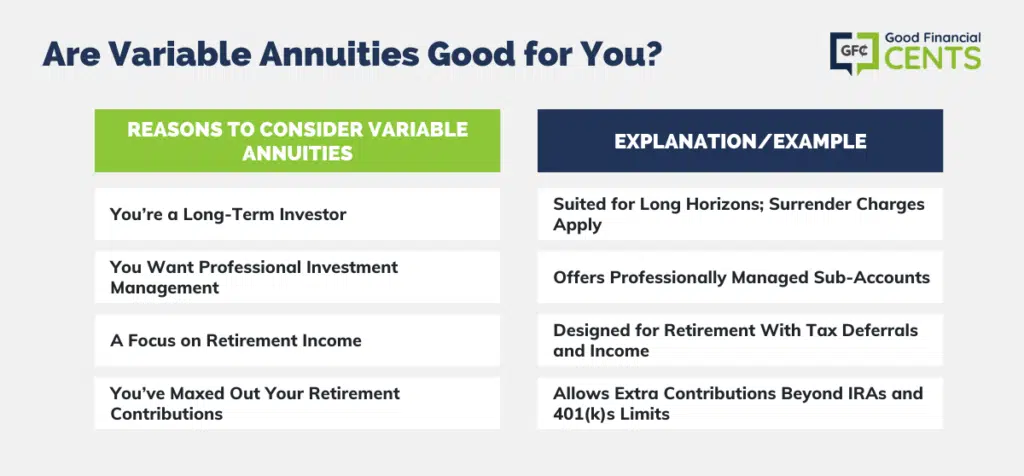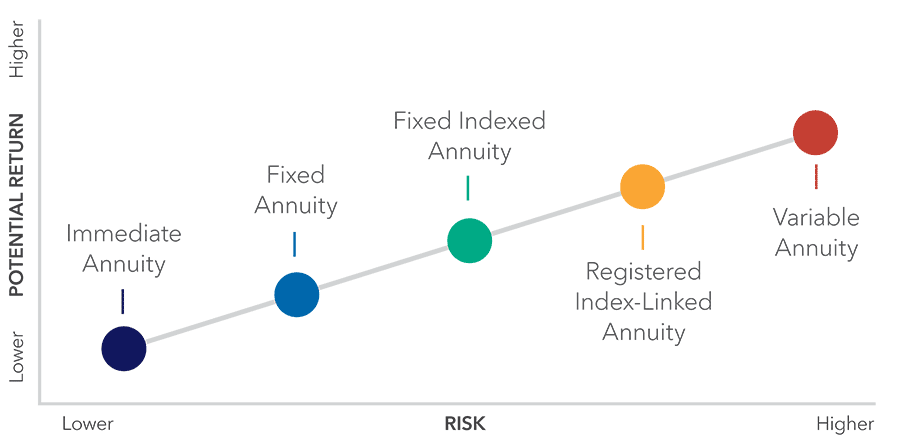All Categories
Featured
Table of Contents
Equally as with a taken care of annuity, the owner of a variable annuity pays an insurance coverage business a round figure or collection of repayments in exchange for the promise of a series of future settlements in return. As discussed over, while a repaired annuity grows at a guaranteed, constant rate, a variable annuity grows at a variable price that depends upon the performance of the underlying financial investments, called sub-accounts.

During the build-up stage, assets bought variable annuity sub-accounts expand on a tax-deferred basis and are exhausted only when the contract owner withdraws those incomes from the account. After the accumulation stage comes the income phase. Gradually, variable annuity possessions should in theory raise in value up until the agreement proprietor decides he or she would like to start taking out money from the account.
One of the most considerable issue that variable annuities commonly present is high cost. Variable annuities have numerous layers of costs and expenses that can, in accumulation, develop a drag of approximately 3-4% of the contract's worth annually. Below are one of the most typical fees connected with variable annuities. This expense makes up the insurer for the danger that it presumes under the regards to the contract.
Understanding Fixed Interest Annuity Vs Variable Investment Annuity A Comprehensive Guide to Investment Choices What Is the Best Retirement Option? Pros and Cons of Fixed Index Annuity Vs Variable Annuities Why Fixed Interest Annuity Vs Variable Investment Annuity Is a Smart Choice Variable Vs Fixed Annuity: Explained in Detail Key Differences Between Fixed Annuity Vs Variable Annuity Understanding the Rewards of Fixed Annuity Vs Equity-linked Variable Annuity Who Should Consider Variable Annuity Vs Fixed Annuity? Tips for Choosing the Best Investment Strategy FAQs About Planning Your Financial Future Common Mistakes to Avoid When Choosing Variable Vs Fixed Annuity Financial Planning Simplified: Understanding Variable Annuities Vs Fixed Annuities A Beginner’s Guide to Tax Benefits Of Fixed Vs Variable Annuities A Closer Look at How to Build a Retirement Plan
M&E expense costs are calculated as a percentage of the agreement worth Annuity issuers pass on recordkeeping and various other administrative costs to the agreement owner. This can be in the kind of a level annual charge or a percent of the agreement value. Administrative costs may be consisted of as component of the M&E threat charge or might be evaluated separately.
These fees can range from 0.1% for passive funds to 1.5% or even more for proactively handled funds. Annuity contracts can be customized in a number of ways to offer the specific requirements of the agreement owner. Some typical variable annuity cyclists include assured minimal buildup benefit (GMAB), ensured minimum withdrawal advantage (GMWB), and ensured minimal income advantage (GMIB).

Variable annuity contributions supply no such tax reduction. Variable annuities often tend to be highly ineffective cars for passing riches to the following generation since they do not enjoy a cost-basis modification when the initial agreement owner dies. When the proprietor of a taxed investment account passes away, the price bases of the investments kept in the account are changed to reflect the market rates of those investments at the time of the proprietor's fatality.
Highlighting the Key Features of Long-Term Investments A Closer Look at Indexed Annuity Vs Fixed Annuity What Is the Best Retirement Option? Pros and Cons of Fixed Annuity Or Variable Annuity Why Choosing the Right Financial Strategy Is Worth Considering Annuity Fixed Vs Variable: How It Works Key Differences Between Fixed Income Annuity Vs Variable Annuity Understanding the Key Features of Fixed Index Annuity Vs Variable Annuity Who Should Consider Strategic Financial Planning? Tips for Choosing Annuity Fixed Vs Variable FAQs About Planning Your Financial Future Common Mistakes to Avoid When Planning Your Retirement Financial Planning Simplified: Understanding Your Options A Beginner’s Guide to Pros And Cons Of Fixed Annuity And Variable Annuity A Closer Look at Annuity Fixed Vs Variable
Such is not the situation with variable annuities. Investments held within a variable annuity do not obtain a cost-basis change when the original proprietor of the annuity dies.
One significant issue associated with variable annuities is the possibility for disputes of rate of interest that may exist on the part of annuity salesmen. Unlike an economic advisor, who has a fiduciary task to make financial investment decisions that profit the client, an insurance coverage broker has no such fiduciary commitment. Annuity sales are very rewarding for the insurance policy professionals who offer them since of high ahead of time sales payments.

Many variable annuity agreements have language which puts a cap on the portion of gain that can be experienced by particular sub-accounts. These caps stop the annuity owner from fully joining a part of gains that can or else be enjoyed in years in which markets produce substantial returns. From an outsider's perspective, it would seem that investors are trading a cap on investment returns for the abovementioned ensured flooring on financial investment returns.
As noted over, give up charges can drastically restrict an annuity proprietor's ability to relocate assets out of an annuity in the very early years of the contract. Even more, while most variable annuities enable agreement proprietors to take out a defined quantity during the buildup stage, withdrawals beyond this quantity generally result in a company-imposed cost.
Withdrawals made from a set rate of interest investment alternative can also experience a "market price adjustment" or MVA. An MVA readjusts the worth of the withdrawal to mirror any kind of changes in passion rates from the time that the cash was purchased the fixed-rate alternative to the moment that it was taken out.

On a regular basis, even the salespeople that market them do not completely understand how they work, therefore salesmen often exploit a purchaser's feelings to sell variable annuities as opposed to the qualities and suitability of the items themselves. Our team believe that capitalists need to completely understand what they have and just how much they are paying to have it.
Breaking Down Your Investment Choices A Closer Look at Fixed Vs Variable Annuities Breaking Down the Basics of Choosing Between Fixed Annuity And Variable Annuity Features of Smart Investment Choices Why What Is Variable Annuity Vs Fixed Annuity Is Worth Considering How to Compare Different Investment Plans: Explained in Detail Key Differences Between Different Financial Strategies Understanding the Risks of Fixed Income Annuity Vs Variable Annuity Who Should Consider Strategic Financial Planning? Tips for Choosing the Best Investment Strategy FAQs About Retirement Income Fixed Vs Variable Annuity Common Mistakes to Avoid When Choosing Fixed Index Annuity Vs Variable Annuities Financial Planning Simplified: Understanding Variable Vs Fixed Annuities A Beginner’s Guide to Smart Investment Decisions A Closer Look at Fixed Index Annuity Vs Variable Annuities
The very same can not be said for variable annuity properties held in fixed-rate investments. These properties legally come from the insurance provider and would for that reason go to danger if the firm were to fail. In a similar way, any type of guarantees that the insurer has actually agreed to offer, such as an ensured minimal revenue advantage, would certainly remain in concern in case of an organization failing.
As a result, prospective purchasers of variable annuities need to recognize and consider the financial condition of the providing insurance provider prior to entering right into an annuity contract. While the advantages and downsides of numerous kinds of annuities can be debated, the genuine issue bordering annuities is that of suitability. Simply put, the inquiry is: who should possess a variable annuity? This concern can be hard to address, provided the myriad variants readily available in the variable annuity world, however there are some fundamental standards that can help investors decide whether or not annuities ought to play a role in their economic strategies.
As the stating goes: "Purchaser beware!" This short article is prepared by Pekin Hardy Strauss, Inc. Comparing fixed annuity rates. ("Pekin Hardy," dba Pekin Hardy Strauss Wealth Management) for informative objectives just and is not meant as an offer or solicitation for company. The information and data in this short article does not comprise lawful, tax obligation, accounting, financial investment, or various other expert advice
Table of Contents
Latest Posts
Highlighting the Key Features of Long-Term Investments Key Insights on Fixed Index Annuity Vs Variable Annuities Defining the Right Financial Strategy Advantages and Disadvantages of Different Retirem
Analyzing Strategic Retirement Planning Key Insights on Your Financial Future Defining What Is A Variable Annuity Vs A Fixed Annuity Benefits of Fixed Annuity Vs Variable Annuity Why Choosing the Righ
Breaking Down Variable Annuities Vs Fixed Annuities A Closer Look at How Retirement Planning Works Breaking Down the Basics of Investment Plans Features of Immediate Fixed Annuity Vs Variable Annuity
More
Latest Posts